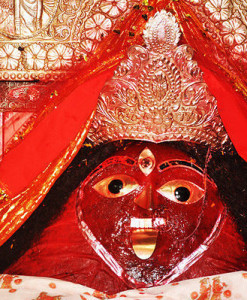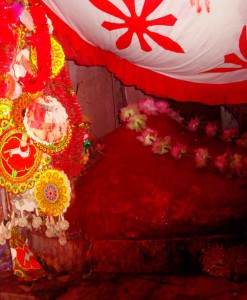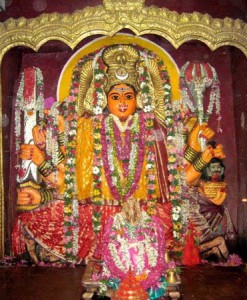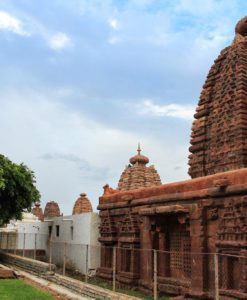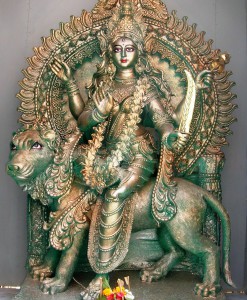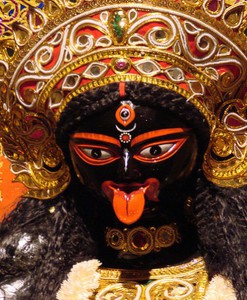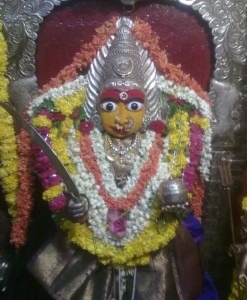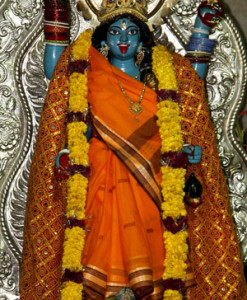No products in the cart.
Nalateswari Temple, Nalhati
Nalateswari Temple is one of the 51 Shakti Peethas, one of the 51 places where parts of Devi Sati’s body fell. This temple is very sacred and visited by devotees from all over the country. Since the throat or ‘nala’ of Sati is believed to have fallen here, the temple came to be called as the Maa Nalateswari Temple. It is believed that no matter how much water is poured down the throat of the goddess, it will never get overflowed or dried up.
- Temple History
- Architecture
- How To Reach The Temple
- Daily Poojas And Festivals
- Videos
- Additional Information
According to the localities, in 252th Bengali year or “Bongapto”, “Kamdev” (the Hindu god of love or desire) who had dreamt about its existence, discovered the larynx of maa sati in the Nalahati forest. Another legend depicts that Ram Sharam Devsharma was known to be the first discoverer of the Nala of Devi Sati and this had marked the beginning of Maa Nalateswri devotion.
In the later half, Bramhachari Kushalnan had offered the first “Bhog” or food offerings. He had started the salvation on the “Pancha-munda-ashana” or the five headed throne. Nalhati is a beautiful place with serene outdoors and plateaus all around. Maa Nalateswri resides in such a soulful location and has resemblance with Kamakha and Kalighat Shakti peethas. Maa Nalateswri is also praised as Maa or “Bhagobidhata-Nalateswri” or Devi Parvati or Kalika.
The beautiful temple of Maa Nalateswari looks magnificent from the outside. While you enter inside, you would be amazed at the architecture of the entrance gateway. As you step in the door way, you would be able to see the “Garb Griha” of the temple straight away, raised over a platform. This drips the feeling of divinity right from the entrance. Now as you enter the gateway of the “Garb Griha”, there is an idol of lord Ganesh, who is being surrounded with eight snakes and is beautified with wonderful colors.
Then comes the main part of the temple. The “Garb Griha” (sanctum sanctorum) is crowned with a raised pinnacle where deity of Maa Nalateswri is worshipped. The feeling of positive energy (that helps to destroy the evils of life) rises within as you look at the deity of Maa. The deity has huge eyes, also known as “Trinayan” (or three eyed deity), red colored tongue made of gold whereas the face is completely laden with sindur or vermilion (the sign of marriage of Hindu women) which is much more beautified with thick eyebrows, teeth, nose and a small forehead. Below the golden tongue there lies the “Nala” or throat of Devi Sati. No matter how much water is being poured down the throat, it will never get overflowed or dried up even in the absence of it for many days. Even when the water moves down the throat there is a sound produced which can be recognized as a gulp echo.

Nalateswari temple is situated in the central (neck) portion of West Bengal in the district of Birbhum under the Sub division of Rampurhat. Nalhati is found to be the nearest railway station. Nalhati is a station which lies in the junction of Azimganj, a connector of Howrah-Sahibgunge, eastern railway loop. You can reach the Mandir via train followed by bus or any other transport. Being located in the Chota Nagpur Plateau this hillock region looks more beautiful with the historic touch of Maa Nalateswari.
The nearest airport to Maa Nalateswari Temple is Rajshahi airport, rajshahi which is 70 KM away from Maa Nalateswari Temple.
Nalateswari Temple, Nalhati
 A major part of the Goddess Kali rituals and observances are the mass prayers that are offered from morning 5:30 am to 8:30 pm.
A major part of the Goddess Kali rituals and observances are the mass prayers that are offered from morning 5:30 am to 8:30 pm.
Timing of Bhog: Around 1pm, there is Rice offering (“Anya Bhog”) is being offered to the goddess that latter on gets distributed as “Prasad” or blessings’ of Maa Nalateswari. A special “Aarti” (Religious ritual of worship with the help of a burning lamp) occurs that gives more activeness to those devotees present at the site. Even blood sacrifices of goats are still prevalent here. The devotees try to seek the blessings of the deity by offering this kind of sacrifices.
Dusshera and Navaratri are regarded as the most auspicious time to visit the temple.
A few kilometres away from the Nalateswari temple lies the shrine of Jogesh Bhairab and on its walls, a pair of footprints of lord Vishnu which amazingly was noticed only in recent times. Though some accept this fact as god’s blessings on this shrine, but no one knows the reality.
Neem Tree, Bargi sardar and Brahmani River are the other places which are worth visiting.


